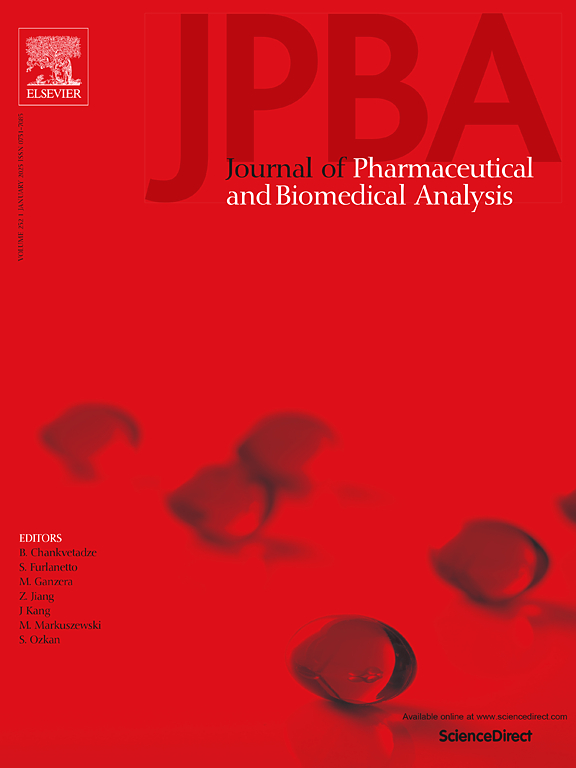Integrated network pharmacology and metabolomics to investigate the effect and mechanism of nitidine chloride against cholangiocarcinoma
IF 3.1
3区 医学
Q2 CHEMISTRY, ANALYTICAL
Journal of pharmaceutical and biomedical analysis
Pub Date : 2025-07-09
DOI:10.1016/j.jpba.2025.117063
引用次数: 0
Abstract
Cholangiocarcinoma (CCA) is an aggressive malignancy with a poor prognosis. Nitidine chloride (NitC), a bioactive alkaloid derived from Zanthoxylum nitidum (Roxb.) DC., exhibits potential anti-cancer activity against CCA. However, the metabolic mechanism underlying the anti-cancer effect of NitC remains poorly understood and requires further elucidation. This study integrated metabolomics and network pharmacology to systematically investigate the anti-cancer activity and underlying mechanisms of NitC in treating human cholangiocarcinoma cells. First, The effects of NitC on human cholangiocarcinoma cells were assessed by cell proliferation, apoptosis, and cycle. Then, potential mechanisms and targets were investigated using a combination of cell metabolomics and network pharmacology and verified by molecular docking. Finally, we measured the protein levels of potential targets in TFK1 cells using enzyme-linked immunosorbent assay (ELISA). Our results indicated that NitC treatment induced the proliferation inhibition, G2/M arrest and apoptosis of TFK1 cells in a concentration dependent manner. The metabolomics analysis identified forty differential metabolic biomarkers and five key metabolic pathways of NitC in treating CCA. Network pharmacology found 36 potential targets for NitC intervention on CCA. The integration of network pharmacology and metabolomics constructed the “compound-reaction-enzyme-gene” association and revealed that NitC exerts its efficacy on CCA through four key targets, eleven metabolic indicators, and glycine, serine and threonine metabolism, and tyrosine metabolism. Molecular docking further confirmed robust binding interactions between NitC and these key targets. Moreover, ELISA results showed that NitC treatment significantly attenuated the protein levels of PIK3CA, PTGS2, and PRKACA in TFK1 cells. This study demonstrates that combining metabolomics and network pharmacology provides a powerful strategy to elucidate the pharmacological mechanisms of natural compounds, also offering new insights into the therapeutic potential of NitC for CCA.
结合网络药理学和代谢组学研究氯化尼替丁抗胆管癌的作用及机制
胆管癌(CCA)是一种预后不良的侵袭性恶性肿瘤。氯化硝替丁(nittidine chloride, NitC)是一种从硝基花椒中提取的生物碱。直流。对CCA具有潜在的抗癌活性。然而,NitC的抗癌作用背后的代谢机制仍然知之甚少,需要进一步阐明。本研究将代谢组学和网络药理学相结合,系统探讨了NitC对人胆管癌细胞的抗癌作用及其机制。首先,通过细胞增殖、细胞凋亡和细胞周期来评估NitC对人胆管癌细胞的影响。然后,结合细胞代谢组学和网络药理学研究潜在的机制和靶点,并通过分子对接验证。最后,我们使用酶联免疫吸附试验(ELISA)测量TFK1细胞中潜在靶点的蛋白水平。结果表明,NitC对TFK1细胞的增殖抑制、G2/M阻滞和凋亡呈浓度依赖性。代谢组学分析确定了NitC治疗CCA的40个差异代谢生物标志物和5个关键代谢途径。网络药理学发现36个NitC干预CCA的潜在靶点。网络药理学与代谢组学的整合构建了“化合物-反应-酶-基因”关联,揭示了NitC通过4个关键靶点、11个代谢指标以及甘氨酸、丝氨酸、苏氨酸和酪氨酸代谢发挥其对CCA的作用。分子对接进一步证实了NitC与这些关键靶点之间强大的结合相互作用。此外,ELISA结果显示,NitC处理显著降低了TFK1细胞中PIK3CA、PTGS2和PRKACA的蛋白水平。本研究表明,结合代谢组学和网络药理学为阐明天然化合物的药理机制提供了强有力的策略,也为NitC治疗CCA的潜力提供了新的见解。
本文章由计算机程序翻译,如有差异,请以英文原文为准。
求助全文
约1分钟内获得全文
求助全文
来源期刊
CiteScore
6.70
自引率
5.90%
发文量
588
审稿时长
37 days
期刊介绍:
This journal is an international medium directed towards the needs of academic, clinical, government and industrial analysis by publishing original research reports and critical reviews on pharmaceutical and biomedical analysis. It covers the interdisciplinary aspects of analysis in the pharmaceutical, biomedical and clinical sciences, including developments in analytical methodology, instrumentation, computation and interpretation. Submissions on novel applications focusing on drug purity and stability studies, pharmacokinetics, therapeutic monitoring, metabolic profiling; drug-related aspects of analytical biochemistry and forensic toxicology; quality assurance in the pharmaceutical industry are also welcome.
Studies from areas of well established and poorly selective methods, such as UV-VIS spectrophotometry (including derivative and multi-wavelength measurements), basic electroanalytical (potentiometric, polarographic and voltammetric) methods, fluorimetry, flow-injection analysis, etc. are accepted for publication in exceptional cases only, if a unique and substantial advantage over presently known systems is demonstrated. The same applies to the assay of simple drug formulations by any kind of methods and the determination of drugs in biological samples based merely on spiked samples. Drug purity/stability studies should contain information on the structure elucidation of the impurities/degradants.

 求助内容:
求助内容: 应助结果提醒方式:
应助结果提醒方式:


